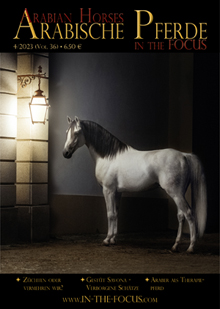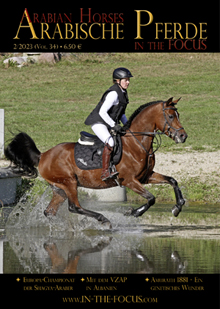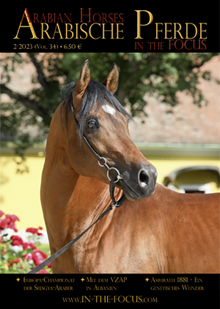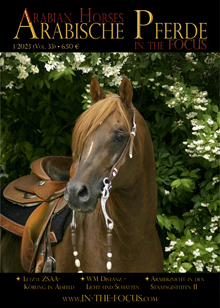Part I: Ancestor loss and inbreeding
A pedigree is more than just a record of descent. If you can read it correctly, it tells you a lot about the horse in question. However, you need a fair amount of background knowledge, to interpret all data and names in the right way.
Breeders of Arabian horses are usually proud of the ancestry of their horses and talk in an almost reverent way of their pedigrees and the names therein. But what looks like just a lot of names on first view, is actually a lot more, if you can read and interpret the information in it in the correct way. For example, a pedigree gives you information about its ancestor loss, inbreeding, about line- and crossbreeding, about sire and damline, about horizontal and vertical inheritance, about a successful “nick”, i.e. a matching combination of certain lines and/or horses, and whether the horse is “Russian”, “Polish” or “Egyptian. In the following article, we will have a look at these terms and what they mean.
Ancestor loss
The first thing, that one realizes in a pedigree are the “known names”, such as of the “stallion of the century” Nazeer. “The more, the better”, some breeders think and are proud of the enrichment of the pedigree with such names. But what does it actually mean?
Generally speaking, each Pedigree (different from a family tree) has regular structure, as each individual has two parents. With that, the number of ancestors doubles in each generation, i.e. each individual has two parents (21), four grandparents (22), eight great-grandparents (23), and so on. However, some ancestors may appear twice or more often in a pedigree, if the parents are related to each other, this is called ancestor loss. In a pure breed, this ancestor loss is almost inevitable, because in fourth generation (great-great-grandparents) the individual in question has 24, that means 16 ancestors, in our mainly used 5 generation-pedigree there are 32 ancestors in the fifth generation.
Assuming a generation interval of 10 years (today, it might be shorter), which is the time until the horse has offspring who reproduce themselves, we have covered a period of 50 years in those five generations. In 100 years, it is 10 generations, and we are looking at 210 (=1024) ancestors. Our oldest pedigrees go back some 200 years, i.e. 20 generations, and thus we have to deal with 220, i.e. more than a million ancestors – but there weren’t that many Arabian horses at that time! Therefore, it is save to assume that certain ancestors appear more than just once in a pedigree, and that is what we call ancestor loss.
Within certain limits, ancestor loss is a totally normal phenomena, and occurs in all purebred horses if you look at enough generations. But ancestor loss is not necessarily identical with inbreeding. To understand this, think of a heavily inbred Icelandic horse (let’s say the result of a father-daughter mating) and mate this with an equally heavily inbred Arabian. Each parent by itself has a high inbreeding coefficient and a high ancestor loss. But the product of such mating has an inbreeding coefficient of zero (i.e. none), because Icelandic horse and Arabians have completely different ancestors. However, it does have a high ancestor loss, because each of the parent have a high ancestor loss because they are inbred (father-daughter mating).
In horse breeding, the ancestor loss is not of much importance, it is rather a side effect of inbreeding. However, we all have to be aware that the ancestor loss in Arabian horse breeding is rather high, if you consider that most of our Arabians trace back to about 500 horses that were originally imported from the desert of which we may assume these original imports were somehow related with each another, too.
Some GeneticsIn order to understand the various technical terms, we need to deal a little with genetics: |
Inbreeding
Inbreeding means the mating of related individuals. Generally, we differentiate three grades of inbreeding:
Incest – mating of individuals of 1st and 2nd degree of relationship (parents x child, full siblings or half siblings among themselves, grandparents x grandchild).
Close inbreeding – mating of individuals of 3rd and 4th degree of relationship (uncle x nice, cousins among themselves).
Moderate inbreeding – mating of individuals of 5th and 6th degree of relationship.
Often, people make a mistake in analysing a pedigree and assessing inbreeding: they only count how often a certain name appears in the pedigree. If it appears several times, people talk about inbreeding. But that is not always true! A name appearing twice (or even more often) in a pedigree does not necessarily mean the individual is inbred, because inbreeding only occurs if the ancestor appears on the sire and dam side (i.e. the two are related).
What is the effect of inbreeding, and why can it be even “dangerous”? In textbooks we read: “The effect of inbreeding is an increasing inbreeding coefficient, which means the probability increases that the two alleles of one gene locus are of the same descent (i.e. they come from the same, common ancestor). This probability can be expressed by the inbreeding coefficient, for example the inbreeding coefficient (F) for mating two full siblings is F=25%, for mating two half siblings F=12.5%.
With the inbreeding coefficient you can define and measure the inbreeding for a horse and especially for individual ancestors and show, how much a horse has been inbred to a certain ancestor. Usually, scientist use the coefficient of inbreeding by Wright, but that is a lot of calculation. That’s why for normal use an approximation is sufficient. The (approximate) calculation of the inbreeding coefficient can be done with the table below.

1. Inbreeding to Aswan (IV. / III.), F = 1,56 % (marked green in our table)
2. Inbreeding to Aswan (IV. / III.), F = 1,56 %
3. Inbreeding to Aswan (IV. / IV.), F = 0,78 %
4. Inbreeding to Aswan (IV. / IV.), F = 0.78 %
5. Inbreeding to Nabeg (IV. / IV.), F = 0,78%
6. Inbreeding to Salon (V. / V.), F = 0,20 %
Borodina (see pedigree page 23) therefore has a total inbreeding coefficient (back to 5th generation) of 5,66 %, of which 4,68% are by Aswan.
Observations in animal breeding have shown that generally speaking, animals or population with a high inbreeding coefficient have a lower vitality, lower resistance against diseases and a lower fertility. This is called inbreeding depression and is caused by the increase of homozygosity. However, there are a lot of examples in horse breeding where despite the homozygosity no decrease (depression) in certain criteria was observed. Therefore, scientists concluded that the increase in homozygosity does not necessarily lead to inbreeding depression, but it might! It is therefore important to use inbreeding only in conjunction with strict selection.
Gudrun Waiditschka













